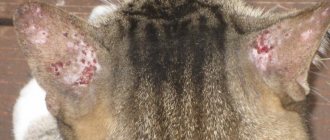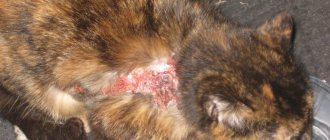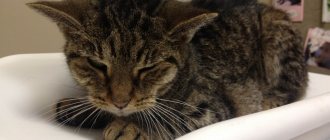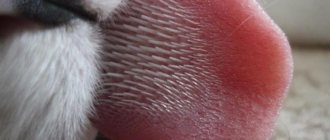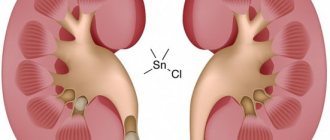If blackness appears in the ears of cats, this indicates poor ear hygiene or is a symptom of ear mites. With otodectosis, the disease has several stages of progression and is accompanied by severe itching, the appearance of crusts, and brown-black discharge. When a cat's ears turn black, the owner should take the pet to a veterinarian, who will diagnose and prescribe treatment.
According to veterinarians, ear parasites affect young cats and kittens whose immune systems are weakened.
What is an ear mite and where does it live?
The main “locations” of ear mites are the ear canal, the tympanic septum and the outer area of the conch. The breeding ground for parasites and their larvae is sulfur. In rare cases, ticks can be found directly on the animal's head.
First of all, cats with weakened immune systems are at risk, especially when kept in a crowded environment, as well as kittens under one year of age. The disease is considered highly contagious and can be transmitted to other pets, although in rare cases.
A person himself can become a carrier of otodectosis by bringing home parasite larvae on the soles of shoes or clothes. Another possible infection option is contact with contaminated rugs, trays, dishes and other everyday items. Flies and fleas can also be “conductors” of the disease.
The tick cannot be seen with the naked eye due to its very small size. It can only be seen under a magnifying glass or microscope by taking a smear from the affected area. The insect has an average size of 0.2-0.7 mm in length, a short body of pale yellow color and elongated limbs.
It feeds on sulfur mass, dumping its biochemical secretions and blood remaining after bites there. As a result, a dark coating of a granular structure forms on the surface of the ear, which is used to initially diagnose the presence of the parasite.
Wax plugs are a non-pathological cause of dirt
Brown plaque is not always a sign of disease. These could be sulfur plugs - voluminous accumulations of natural substances due to insufficient care. Wax plugs do not cause discomfort to the pet and do not cause pain. However, prolonged exposure to the ear can lead to the development of an inflammatory reaction. Removal of sulfur plugs is carried out with a special lotion that dissolves them. If this does not help, then the help of a veterinarian is required. After the plugs come off, treatment with Chlorhexidine is recommended. You can avoid wax buildup with regular inspections and cleanings. If a cat has a unique structure of the hearing organ, for example, like sphinxes, then more careful control is required. They secrete sulfur in large quantities.
Characteristic symptoms
The animal cannot say in words what exactly is bothering it, so it expresses its discomfort through various behavioral actions. In the case of ticks, these will be the following symptoms:
- The cat begins to behave very restlessly, constantly jerking its head, as if trying to shake off parasites.
- He tries to get into the ear canal with his paws, gets nervous when he can’t penetrate deeper, and scratches his ears until they bleed.
- In a desire to get rid of constant itching, the cat looks for hard, stable pieces of furniture to rub its head on, or “sticks” to door frames, corners and steps.
- Dark brown and brown liquid oozes from the combed ears. An unpleasant odor appears. The pile in the lower area of the ear tassels sticks together.
- Partial or complete loss of hearing is observed.
- Body temperature rises slightly.
Important: in order not to blur the clinical picture, it is not advisable to carry out any hygiene procedures before visiting the veterinarian. You should also refrain from instilling drops or applying any ointments.
Allergy
Atopic dermatitis
Allergy is a hypersensitive response to an irritant.
Crusts on the ears occur with the following types of allergies:
- Flea dermatitis: the body becomes sensitized to the saliva of the arthropod and with repeated bites a violent reaction develops. In addition to the ears, the inflammatory process with the formation of crusts spreads to the neck, muzzle, and torso.
- Atopic dermatitis is a reaction to external irritants: pollen, smoke, perfume. Dry eczema develops. The pathology is congenital and occurs in predisposed individuals.
- Contact dermatitis - occurs with the same symptoms as atopic dermatitis, but is not congenital and can be treated.
- Food allergy: develops in cats predisposed to an inadequate reaction to any food ingredient. It occurs with signs of dry eczema.
- Reaction to medications: occurs due to individual intolerance. Characterized by skin rashes or swelling.
- Photosensitization - the mechanism of its occurrence has not been sufficiently studied. Endotoxins accumulate in the skin, which, when exposed to sunlight, cause burns reminiscent of those that a person gets on the beach. Short-haired individuals of white color suffer.
Sunburn due to photosensitivity
Allergic manifestations are treated by eliminating the causes.
Depending on the type of allergy, the following remedies are used:
- insecticides;
- anti-inflammatory corticosteroids;
- antihistamines;
- hypoallergenic ready-made food;
- wound healing ointments.
Treatment options
Effective medicines to combat ear mites are insecticide-based products. The only point that needs to be taken into account is that they act specifically on living parasites, but are absolutely not effective in killing larvae. Since the incubation period of infection is 21 days, the course of therapy should last at least three weeks, covering the entire life cycle of the tick.
- Drops. Most often, the following drugs are prescribed: Tresaderm, Ivomek, Bars, Amitrazine Plus, Otoferonol Gold, Tsipam. The advantage of using Tresaderm is that the antibiotic included in its composition affects not only the adult tick, but also its eggs, and at the same time fights fungi and other infectious inflammations. The drug Ivomec can be prescribed in the form of injections and injected into the animal according to a schedule several times a month. The remaining drops from the above list tend to affect worms if they are present.
Important: so that the cat does not get nervous during instillation, the liquid must be slightly warmed up.
- Ointments (aerosols). Aversectin ointment works well in practice, which is applied to the ear with a special spatula and is well absorbed into the skin during rubbing. Amit ointment, made on the basis of amitraz and prednisolone, has a similar acaricidal effect. Disinfection of the ears is carried out twice a day for 5 days. A cotton swab is lubricated with a creamy substance and then gently rubbed into the skin. Acaromectin spray, sprayed onto the inner surface of the ear according to the attached instructions, is effective against otodectosis.
A doctor may also prescribe Stronghold, Frontline or Oridermil, but these drugs are contraindicated for use as self-medication - only on the recommendation of a veterinarian. For preventive purposes, the drug Revolution for Cats is often prescribed - It is applied to the withers using a drop method. After absorption into the skin, the active substance acts simultaneously on both ticks and fleas, if any.
How to help your pet?
It is necessary to show the animal to a veterinarian to identify the exact cause of the formation of wounds and crusts. In case of allergic reactions, the allergen must be identified and eliminated. To avoid infection, the ears are treated with any antiseptic. Additionally, it is recommended to use special drops for cleaning cats’ ears.
Solar eczema often requires surgery, during which the tips of the ears are trimmed. This is necessary to prevent the development of skin cancer against the background of photodermatitis.
Treatment of tick-borne dermatitis is carried out in several stages. First, you need to adjust your pet’s diet in such a way as to normalize the immune defense and direct all the body’s forces to fight parasites. Then the doctor selects drugs to combat the tick. These can be either tablets or skin treatment products. Antiseptic treatment of the ears is mandatory to avoid infection of the wounds. If this cannot be avoided, treatment is supplemented with antibacterial therapy.
Sometimes crusts on the tips of a cat's ears indicate injuries received during contact with relatives. If the wounds are small, do not cause discomfort and the animal feels well, there is no need to treat them. The maximum that can be done is to treat the ears with an antiseptic; otherwise, the furry pet’s body will cope on its own.
In rare cases, the formation of crusts on the tips of the ears can be a consequence of otitis media and other infections. If, in addition to wounds, there is discharge from the ears, you should show the cat to a specialist as soon as possible, but do not try to treat it yourself.
I graduated from the National State Agricultural Academy and have been working as a veterinarian for 8 years.
In my free time, I write articles about the diagnosis and treatment of cats.
Feel free to ask questions in the comments, I will try to answer everything.
Source
Having discovered painful lesions on the body of their pet, any owner will become concerned. Sometimes you can notice crusts on your cat’s ears that do not go away for a long time. In a healthy state, the animal's ears are clean and have a uniform light pink color. The formation of crusts clearly indicates pathology. What could be the reason for the formation of crusts in the ear area, we will consider in the article.
Rules for the use of medicines
The sequence of actions during therapy should be as follows:
- Before dripping or applying ointment, it is necessary to clean the ear surface of all dirt, crusts and purulent discharge. This is done with a cotton swab soaked in camphor alcohol (2%) or hydrogen peroxide. Alternatively, you can use other disinfecting lotions designed for ears.
- When all the impurities become limp and “move away” from the skin, they can be easily removed with a cotton swab. Often the cat itself “shakes out” all the dirt from its ears with its paws.
- In order for the medicine to get deep into the ear canal and be well absorbed, you need to massage the base of the ear with light movements.
- The dosage of the medicine must strictly comply with the instructions or doctor’s prescriptions.
- If there is another cat or other animals living in the house, it is recommended to ventilate living areas more often and do wet cleaning during the treatment period. In this way, the likelihood of re-infection and infection of healthy pets is reduced.
Symptoms of ear diseases in cats
Cats, like humans, regularly accumulate small amounts of wax in their ears. This is a natural process that does not lead to pathologies.
The cat is a clean creature and usually takes care of its ears on its own. The formation of unhealthy crusts may be accompanied by other manifestations.
The following symptoms indicate the disease:
- Clear signs of discomfort in the animal. The cat constantly rubs its head with its paws, shakes it off, tilts it, and turns its muzzle in one direction.
- Atypical discharge from the ears. The secretion has a color and consistency different from ordinary sulfur and smells bad.
- Redness. In addition to discharge, crusts, plaque, the ears become red inside with signs of inflammation.
- Swelling. The auricles swell in the area of the passage, the tissues practically block the hearing aid.
- Temperature. The cartilage tissue becomes noticeably hot. When healthy, cats have cold ears.
- Itching. The animal scratches its head constantly and for a long time.
- General malaise. The pet looks lethargic, is inactive, eats poorly, and sleeps for a long time.
Some diseases are practically asymptomatic and, apart from crusts on the cat’s ears, the owner will not notice any other strange signs.
Folk remedies
If for some objective reason a visit to the doctor is temporarily impossible, then traditional medicine comes to the rescue. Herbs and lotions are unlikely to be able to completely cure otodectosis, but they may well be able to alleviate the animal’s suffering until the time of visiting the veterinary clinic.
- Green tea based drops. A tablespoon of dry leaves is poured into a glass of water and left for 5-10 minutes. After cooling to a warm state, the solution is taken into a pipette and a few drops are instilled into each ear.
- Garlic has powerful antiseptic properties. In the case of ear mites, it is infused in oil for 24 hours, and then the resulting solution is instilled into the ears once a day. Olive, flaxseed, sunflower, almond and other oils are used as the basis for the tincture.
- Celandine juice is instilled into the ears in the morning and evening, two drops per ear. Freshly picked herbs are ground in a meat grinder and then squeezed in gauze to prevent any remaining leaves or stems from getting into the juice ready for use.
And the last thing you should not forget about is to try to give the cat maximum attention and care in order not only to alleviate its suffering, but also to speed up the healing process.
